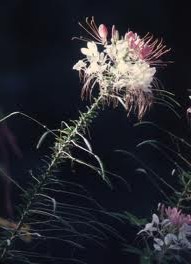The spiderwisp looks like a mustard that lost its way or got some psychedelic-laced fertilizer. It has four-petaled flowers as the mustards do, seed pods similar to mustards, and its cooked leaves taste similar to radishes, closely related to mustard. The Spiderwisp’s oil however, is closer to garlic in taste making the species quite usable all around.

Four petal blossoms
The Cleome clan is some 170 species growing in nearly every mild, subtropical or tropical climate in the world. With their unique flower clusters they got dubbed “spiderwisp” though they’re also called Cat’s Whiskers, Spider Flower and, off theme, African Cabbage. The aromatic five lobed leaves are prickly growing on strong stems. The flower heads are delicate pink, purple or white racemes with very long stamens. Spiderwisp is easy to grow and generally free of pests.
Spiderwisp is also something of an heirloom species. Thomas Jefferson grew them at Monticello. DNA testing reduced the family by some 75 species and show that they are closely related to the brassica family, which includes mustards. Despite family issues the Spiderwisp is considered good eats. Besides flavor it’s high in calcium, iron, and vitamins A and C. Often Spiderwisp is mixed with other greens to add flavor. In its native Africa Spiderwisp is also used to make relishes, side dishes, stews, is pickled with salt and added to rice for flavor. Leaves are dried, ground, mixed with fresh leaves and used to ween children.
Botanically Spiderwisp is currently Cleome gynandra (Klee-OH-may yin-ANN-dra ) though it has also been Gynandropsis gynandra, Cleome pentaphylla and a dozen other botanical names. Cleome is dead Latin for the Greek word κλέος (KLEE-ohs) meaning “renown” and was a name philosopher Theophrastus gave to a plant that resembled mustards. Gynandra is Greek for “female/male, combining yin and andros though I am sure someone will say gin-AN-dra or ghine-AN-dra. In Greek the “gamma” before certain sounds is soft, yin not gin or ghine. Anyway, Gynandra usually refers to the union of the pistil and stamens, the male and female parts of the flower.
In the unspoken language of flowers giving Spiderwisps says you want the recipient to elope with you.
Green Deane’s “Itemized Plant Profile” Spiderwisp
IDENTIFICATION: Cleome gynandra: Spiderwisp is a branched, hairy herb, growing to three feet or so with purplish stems that have longitudinal parallel lines. The leaves have very long petioles and five leaflets. Leaflets are obovate or oblong obvate, pointed at the base, abruptly pointed at the tip. Flowers are racemes terminating in showy flowers somewhat spiderish in appearance. The sepals are lancelolate, green. Petals are white or tinged with purple to a half-inch, fruit a cylindrical capsule to four inches (10 c.) with many small, dark brown seeds.
TIME OF YEAR: In the wild nearly year round depending upon climate, under cultivation plant as you would okra, read after any possible frost. Slow growing in the spring. Can be planted in May, in flower from July to August, seeds September on.
ENVIRONMENT: Drought tolerant but they grow their best in moist well-drained soil and full sunlight. It is pollinated by ants.
METHOD OF PREPARATION: Numerous. Tender leaves, young shoots and flowers eaten boiled as potherb or used as in relish, stew or as a side dish. The leaves are used fresh or dried as powder. Very bitter leaves are cooked in milk. The leaves can be blanched, shaped into small balls and dried. Dried it can be stored up to a year. Soak in water before using. Ground seeds are a mustard substitute.
Herb Blurb
Abstract
The repellency of the essential oil of the previously reported anti-tick pasture shrub Gynandropsis gynandra and identified constituents of the oil were evaluated against the livestock tick, Rhipicephalus appendiculatus. In a tick-climbing repellency bioassay, the oil of G. gynandra exhibited a repellency effect which at the highest treatment levels was higher than that of the commercial arthropod repellent N,N-diethyltoluamide. Twenty eight compounds were identified in the G. gynandra oil by GC, GC-MS and coinjection with authentic samples. Carvacrol was found to occur in largest quantity (29.2%), followed by trans-phytol (24.0%), linalool (13.3%), trans-2-methylcyclopentanol (7.2%) and β-caryophyllene (4.4%). m-Cymene, nonanal, 1-α-terpineol, β-cyclocitral, nerol, trans-geraniol, carvacrol, β-ionone, trans-geranylacetone, and nerolidol were the most repellent components against R. appendiculatus. Methyl isothiocyanate which occurred in the G. gynandra oil at a relative percentage of 2.1 and which was not tested in the bioassay due to its toxicity may also contribute significantly to the repellency of the oil. The repellency of the oil of G. gynandra supported earlier findings by other workers that G. gynandra repelled R. appendiculatus ticks.





